Concrete and steel – the farm building materials of choice for the last 100 odd years – are hard to beat in terms of structural integrity and longevity.
But they have a number of disadvantages; firstly, they are expensive to construct, difficult to alter after being built and concrete and steel have a high carbon footprint. And from a calf shed point of view, it is probably not ideal.
Calves should be warm, have a dry lie and breathe fresh air. Achieving a dry lie in a calf shed is easy to achieve. It’s regulating body temperature and ensuring fresh air where the challenges occur.
Think back to what happens in nature. For the first few weeks of the calf’s life, it will lie tucked in next to its mother who acts like a big radiator for the calf, emitting heat at 38°C and providing shelter. In nature, the calf would be outside so there would be lots of fresh air.
In a dairy situation, where the calf is taken from the cow, the calf shed needs to provide the same conditions and this is a challenge.
Most cattle sheds work off the principle of the stack effect.
Animals produce heat and hot air rises. This air exits the shed via roof vents and is replaced by fresh air coming in the sides.
However, calves don’t generate enough heat to make air rise; therefore, even sheds with very good ventilating materials on the roof and sides may have stale air in the shed as there’s nothing to push it out.
Insulation
As for lack of heat, this is perhaps more of an issue with young calves, less than two weeks of age. If they are housed in particularly cold sheds they will need some extra insulation.
Things such as a deep bed of straw, timber canopy in the pen and red lamps will provide extra heat and warmth for young calves.
Older calves are better able to withstand cold temperatures. Increasing feeding rates during cold periods is also a defence mechanism against chills and low thrive during cold weather.
Scotland
Farming Partners started in 2012 as a partnership between the Muldowney family from Kilkenny and the Beattie family from Scotland.
Since then, the business has grown substantially with over 1,800 cows being milked between Ireland and Scotland.
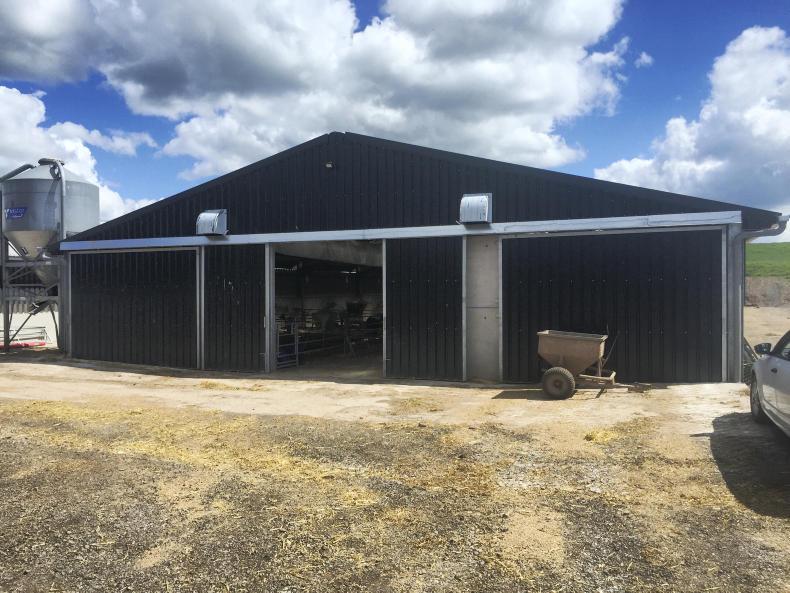
The exterior of the new calf shed.
More partners have entered the business, mostly farm managers who own a percentage of their herd and get a share of the profits.
Conscious of the businesses obligation to provide a high standard of care for calves, an impressive new calf sheds were built just in time for the 2019 calving season.
Sexed semen and more beef sires were used during the 2018 breeding season, which increased the value of calves born last spring.
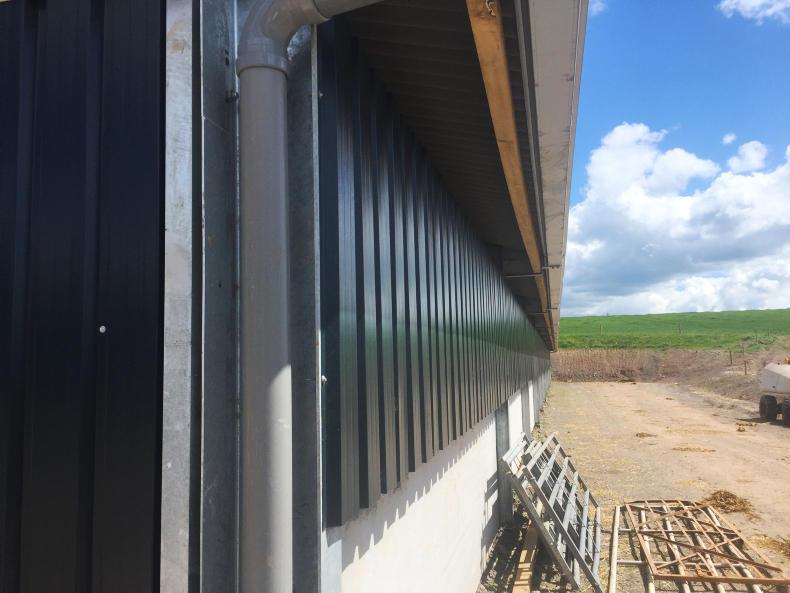
There's a slight overhang on the roof preventing rain from entering the shed through the side sheets.
These were reared on farm and then sold, meaning fewer calves went as bobby calves.
The buildings are impressive. The two sheds are capable of housing 400 calves each.
The sheds were built on a dedicated heifer-rearing farm which is centrally located between the three large-scale dairy farms in Scotland.
At peak, there are over 60 calves arriving into the heifer-rearing unit per day and this presents challenges for New Zealand-born manager Daniel Turnhout.
Both sheds are identical, being 10 bays long with a central feed passage and calf pens at either side.
The pens consist of a straw/woodchip lie-back, with a timber board separating the lying area from a plastic slatted feed area.
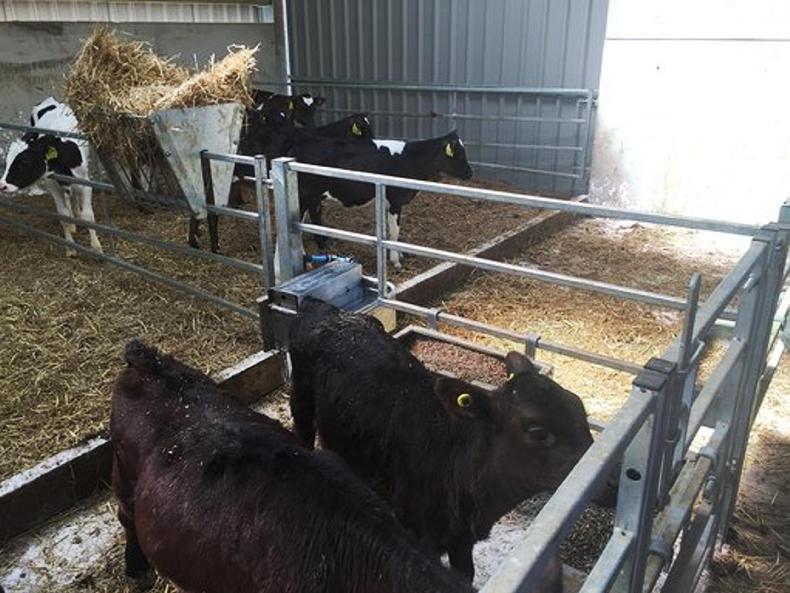
Calves are fed on a plastic slatted area.
The dividing gates can be closed back to lock the calves into the feed area when the shed is being cleaned out. There are two square metres of floor space available per calf.
There are 30 pens per shed with 13 calves in each pen and these are fed using a 13-teat feeder. Calves have access to freshwater, meal and straw at all times.
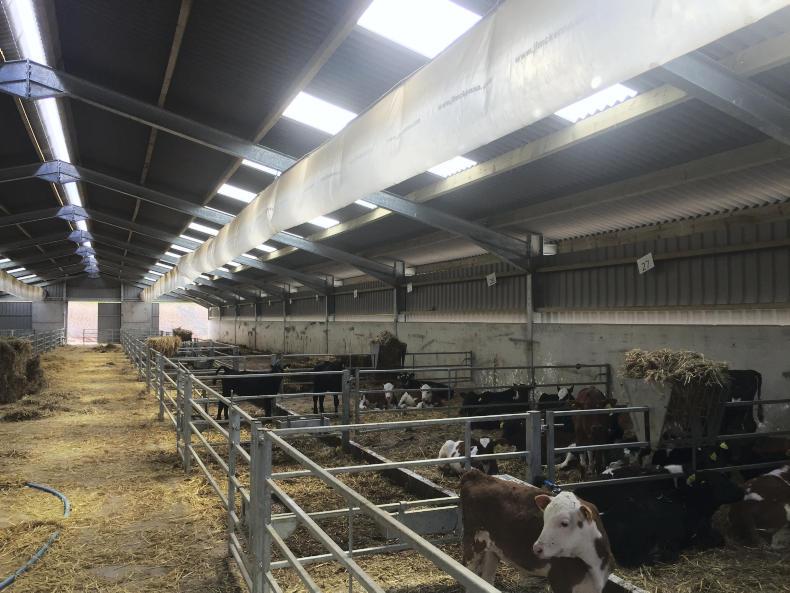
Each shed has 15 pens with 13 calves so can hold 400 calves.
The slatted feed area is constructed over a 1m deep block wall channel, which is connected to an effluent storage tank. Daniel says the plastic slats caused problems, getting clogged up with straw.
The team of Daniel and three others clean out the shed every three weeks. The pens are limed, disinfected and bedded with straw.
A straw chopper/blower is not used as it is felt that it would be too dusty for the calves.
An open ridge in the roof allows stale air out, while perforated side sheeting allows fresh air in.
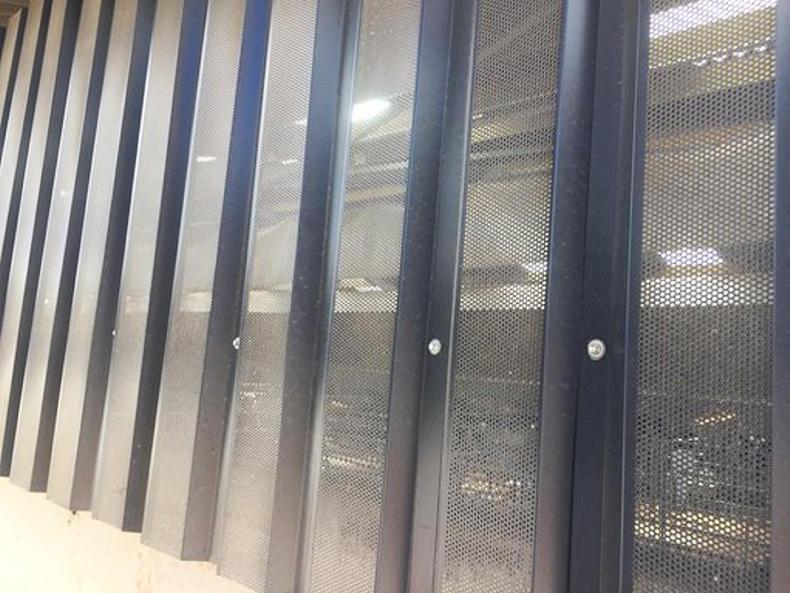
Perforated sheeting instead of vented sheeting on the sides.
Each shed has two mechanical fans blowing fresh air in and out through a perforated duct. The ducts run the length of the shed over both pens.
These push fresh air in, blowing stale air out. According to Brendan Muldowney, the total cost of the investment was £250,000 (€270,000) or €340 per calf space, including all construction work and penning.
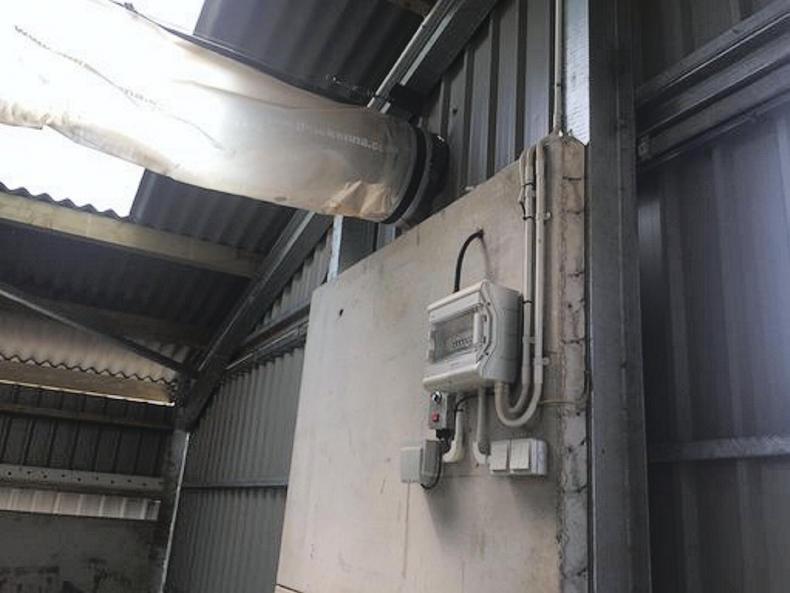
Mechanical ventilation.
Brendan says there continues to be good opportunities in Scotland for young people looking to progress in dairy farming.
At this stage, a significant proportion of the people working in the business were educated in Ireland and he says there are always more opportunities coming up.
Cork
Lean-to style sheds have enough natural ventilation, meaning mechanical ventilation is usually not necessary.
Of course, the issue with open sheds is that if the rain is coming from the direction of the open side then the bed and the calves will get wet.
Also, there is the added risk of draughts. On the plus side though, they are cheaper to construct, easier to clean out and can serve other functions when not full of calves.
This shed, on Kevin Twomey’s dairy farm in Cork, is used to house three groups of 30 to 40 calves in each group.
Calves go into this shed after a few days old when they are sucking strong. Up to recently, the calves were fed by opening the gates and letting the calves out to a small yard to suck from a trailed calf feeder.
However, the challenge was to get the calves back into the pen and get the feeder out. It was a two-person job and was time consuming and frustrating.
The solution? Leave the calves in the pen and back the feeder in, without opening the gates.
Homemade rectangular pens allow the calf feeder to be backed in and taken out again, without the calves leaving the pen.

The calf feeder is more rectangular-shaped than most other makes.
Calf feeding is now a one-person job and all the calves can be fed much quicker and easier.
The calf feeder design has a part to play in making this system work. Round or rugby ball-shaped feeders don’t work as well as too many of the teats are out of reach of the calves.
The calf feeder on the Twomey farm is rectangular-shaped, meaning most of the teats are accessible except the ones on the very front. The pen cost very little to make and can be lifted out for cleaning.
Read more
Polytunnel housing for calves
Dairy management: soil temperatures, calf weights and calf housing
Grass+: putting a plan in place to build grass
Concrete and steel – the farm building materials of choice for the last 100 odd years – are hard to beat in terms of structural integrity and longevity.
But they have a number of disadvantages; firstly, they are expensive to construct, difficult to alter after being built and concrete and steel have a high carbon footprint. And from a calf shed point of view, it is probably not ideal.
Calves should be warm, have a dry lie and breathe fresh air. Achieving a dry lie in a calf shed is easy to achieve. It’s regulating body temperature and ensuring fresh air where the challenges occur.
Think back to what happens in nature. For the first few weeks of the calf’s life, it will lie tucked in next to its mother who acts like a big radiator for the calf, emitting heat at 38°C and providing shelter. In nature, the calf would be outside so there would be lots of fresh air.
In a dairy situation, where the calf is taken from the cow, the calf shed needs to provide the same conditions and this is a challenge.
Most cattle sheds work off the principle of the stack effect.
Animals produce heat and hot air rises. This air exits the shed via roof vents and is replaced by fresh air coming in the sides.
However, calves don’t generate enough heat to make air rise; therefore, even sheds with very good ventilating materials on the roof and sides may have stale air in the shed as there’s nothing to push it out.
Insulation
As for lack of heat, this is perhaps more of an issue with young calves, less than two weeks of age. If they are housed in particularly cold sheds they will need some extra insulation.
Things such as a deep bed of straw, timber canopy in the pen and red lamps will provide extra heat and warmth for young calves.
Older calves are better able to withstand cold temperatures. Increasing feeding rates during cold periods is also a defence mechanism against chills and low thrive during cold weather.
Scotland
Farming Partners started in 2012 as a partnership between the Muldowney family from Kilkenny and the Beattie family from Scotland.
Since then, the business has grown substantially with over 1,800 cows being milked between Ireland and Scotland.

The exterior of the new calf shed.
More partners have entered the business, mostly farm managers who own a percentage of their herd and get a share of the profits.
Conscious of the businesses obligation to provide a high standard of care for calves, an impressive new calf sheds were built just in time for the 2019 calving season.
Sexed semen and more beef sires were used during the 2018 breeding season, which increased the value of calves born last spring.

There's a slight overhang on the roof preventing rain from entering the shed through the side sheets.
These were reared on farm and then sold, meaning fewer calves went as bobby calves.
The buildings are impressive. The two sheds are capable of housing 400 calves each.
The sheds were built on a dedicated heifer-rearing farm which is centrally located between the three large-scale dairy farms in Scotland.
At peak, there are over 60 calves arriving into the heifer-rearing unit per day and this presents challenges for New Zealand-born manager Daniel Turnhout.
Both sheds are identical, being 10 bays long with a central feed passage and calf pens at either side.
The pens consist of a straw/woodchip lie-back, with a timber board separating the lying area from a plastic slatted feed area.

Calves are fed on a plastic slatted area.
The dividing gates can be closed back to lock the calves into the feed area when the shed is being cleaned out. There are two square metres of floor space available per calf.
There are 30 pens per shed with 13 calves in each pen and these are fed using a 13-teat feeder. Calves have access to freshwater, meal and straw at all times.

Each shed has 15 pens with 13 calves so can hold 400 calves.
The slatted feed area is constructed over a 1m deep block wall channel, which is connected to an effluent storage tank. Daniel says the plastic slats caused problems, getting clogged up with straw.
The team of Daniel and three others clean out the shed every three weeks. The pens are limed, disinfected and bedded with straw.
A straw chopper/blower is not used as it is felt that it would be too dusty for the calves.
An open ridge in the roof allows stale air out, while perforated side sheeting allows fresh air in.

Perforated sheeting instead of vented sheeting on the sides.
Each shed has two mechanical fans blowing fresh air in and out through a perforated duct. The ducts run the length of the shed over both pens.
These push fresh air in, blowing stale air out. According to Brendan Muldowney, the total cost of the investment was £250,000 (€270,000) or €340 per calf space, including all construction work and penning.

Mechanical ventilation.
Brendan says there continues to be good opportunities in Scotland for young people looking to progress in dairy farming.
At this stage, a significant proportion of the people working in the business were educated in Ireland and he says there are always more opportunities coming up.
Cork
Lean-to style sheds have enough natural ventilation, meaning mechanical ventilation is usually not necessary.
Of course, the issue with open sheds is that if the rain is coming from the direction of the open side then the bed and the calves will get wet.
Also, there is the added risk of draughts. On the plus side though, they are cheaper to construct, easier to clean out and can serve other functions when not full of calves.
This shed, on Kevin Twomey’s dairy farm in Cork, is used to house three groups of 30 to 40 calves in each group.
Calves go into this shed after a few days old when they are sucking strong. Up to recently, the calves were fed by opening the gates and letting the calves out to a small yard to suck from a trailed calf feeder.
However, the challenge was to get the calves back into the pen and get the feeder out. It was a two-person job and was time consuming and frustrating.
The solution? Leave the calves in the pen and back the feeder in, without opening the gates.
Homemade rectangular pens allow the calf feeder to be backed in and taken out again, without the calves leaving the pen.

The calf feeder is more rectangular-shaped than most other makes.
Calf feeding is now a one-person job and all the calves can be fed much quicker and easier.
The calf feeder design has a part to play in making this system work. Round or rugby ball-shaped feeders don’t work as well as too many of the teats are out of reach of the calves.
The calf feeder on the Twomey farm is rectangular-shaped, meaning most of the teats are accessible except the ones on the very front. The pen cost very little to make and can be lifted out for cleaning.
Read more
Polytunnel housing for calves
Dairy management: soil temperatures, calf weights and calf housing
Grass+: putting a plan in place to build grass








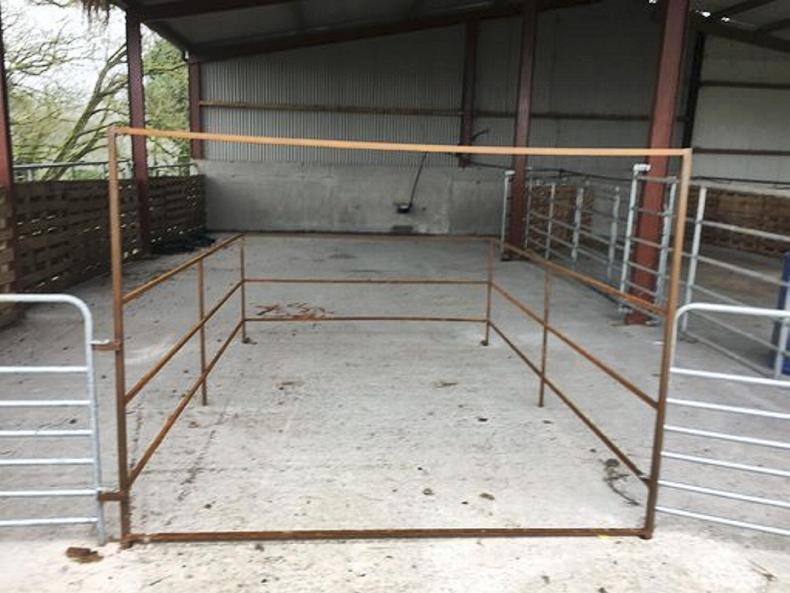




 This is a subscriber-only article
This is a subscriber-only article










SHARING OPTIONS: